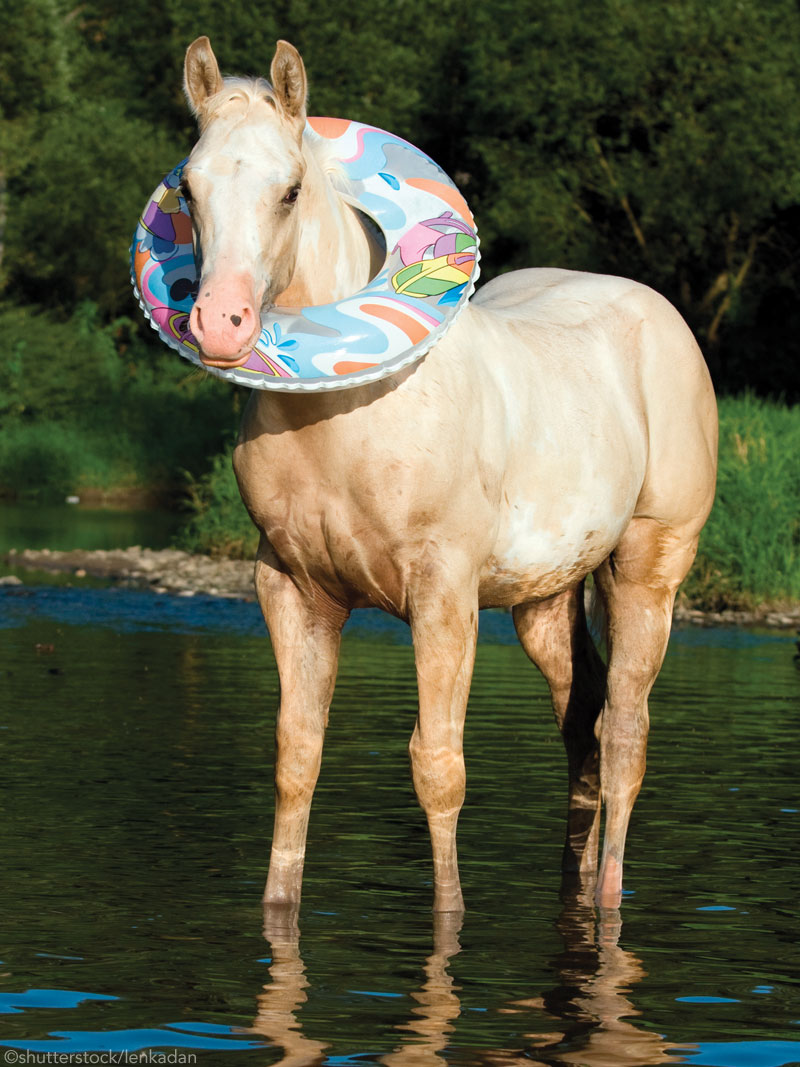 Imagine swimming with your horse: Galloping across a golden beach, hair and mane flying in the wind together, the exhilarating splash as hooves churn up waves, and finally, a fantastic feeling of floating, freedom, buoyancy.
Imagine swimming with your horse: Galloping across a golden beach, hair and mane flying in the wind together, the exhilarating splash as hooves churn up waves, and finally, a fantastic feeling of floating, freedom, buoyancy.
The problems start long before you get to the water. Very few public beaches allow horses and riders, so you’ll likely to be stuck swimming in unimproved areas. Rather than a smooth, sandy walk into the water, you’ll face either slippery-but-sharp rocks or mud. And not just the kind of mud that develops in your sacrifice paddock every spring.
In many lake beds, and on certain ocean beaches at low tide, there is a dark, gooey layer of silt, sand, and decaying organic matter. It is incredibly exhausting to move through, often heavily polluted, and quite deep. Every year, hundreds of horses have to be dragged out of deep mud with slings attached to heavy equipment.
Speaking of equipment, let’s talk tack. Every piece of you put on your horse before heading into the water means more water-logged weight he has to carry, and one more thing to get stuck on wood snags, abandoned fishing lines, and get tangled around your horse’s leg. However, if you head into the water with as little tack as possible, you’re also giving up control and security.
Once in the water, the situation only worsens. While horses can swim if they have to, nature has designed the average equine to be about as seaworthy as a camper trailer. First of all, they don’t float well; horses carry more of their weight on their front end, making it hard for them to keep their heads above water. (Having to heft a human doesn’t help.) Secondly, their long, bony legs are completely wrong for generating forward movement in water. (Imagine trying to paddle a boat with baseball bats.) Horses are even worse at turning in the water, because they can’t easily move their limbs sidewise. Unless a horse can touch a firm bottom, the swim you were hoping to take can quickly turn into a thrashing, panicky drowning.
Good riders can often help their horses overcome panic, but deep water makes us almost powerless. You can’t ask your horse to bend and go in circles in the water. You can’t ask him to stop—moving is the only thing keeping his head above water. And if you jump off to try to lead your horse to safety, you risk getting kicked by one of those thrashing legs. This is assuming, of course, that you’re a good enough swimmer to even consider paddling back to land while hauling on a rein.
When was the last time you swam? If it’s been a while, try swimming sans horse horse first. Walk through the wet sand (or mud) for a good 20 minutes as a warm-up. Then head into the water and try swimming without touching the bottom for five minutes. Are you exhausted? Remember, this is what you’d be asking your horse to do—but with a rider on his back!
Splash Zone Ponies
If all of this puts you off the idea of swimming with your horse, maybe that’s for the best. Here are three safer ways to play with water and your horse at the same time.
- Try some water crossings. If you’ve ever had to turn back on a trail because your horse refused to go through a shallow stream, or had your horse spook at puddles, now’s the time to practice. Pick a stream or pond with a fairly firm bottom that you feel comfortable wading through yourself if you have to. (See “Water Crossing with Jonathan Field” for more.)
- Build an equine splash pad in your pasture. Fill up plastic kiddie pools, set out some sprinklers, round up some pool toys, make a mud puddle, and turn on the bubble machine! You’ll have a blast riding through this watery obstacle course. Not only is this a fun way to beat the summer heat, it’s a great chance to desensitize your horse to some unusual experiences. For a more practical bonus, incorporate real rain gear. When you find yourself stuck riding in a downpour, you’ll be glad your horse already knows about raincoats, rubber boots, umbrellas, and big towels.
- Is your horse already bombproof? Prove it by having a water fight on horseback! Break out the water balloons and squirt guns for an outrageously good time.
HorseChannel.com’s web editor respectfully disagrees with the opinions expressed above.
Wanna go for a swim anyway? Here’s some common-sense advice on what to do before you take the plunge.
Laura Rose lives on a farm in Wisconsin where she blogs, paints and sometimes rescues horses.
This article originally appeared in the July 2015 issue of Horse Illustrated magazine. Click here to subscribe!







I truly believe I had a guardian angel growing up. My brother and I rode bareback into our pond often with our ponies when we were 9 and 11 years old. We knew to give them their heaad and never interfered with where they wanted go. The pond was probaby was 12 feet deep or so. They took very good care of us and they and we enjoyed this often. I would not have done this on most horses, but these were careful with us.
Swimming with your horse or pony is much easier if you go across slow moving streams with narrow central deep sections. Turn your horse with it’s head facing down-stream in the deeper center of the water. The current will help your horse move through the water with little effort.
If the horse panics, turn the horse to the banks of the river and exit.
I’ve trained my equine buddies to carry me bare back and respond to neck reining while wearing a rope halter. My Arab and my Paint allowed me to grab their long tails so they could tow me behind them.